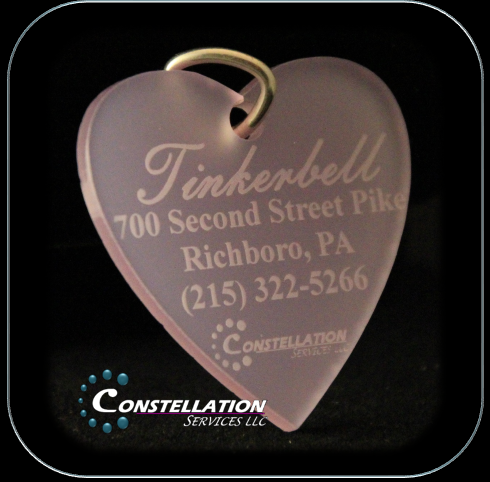Main menu:

• Can be resized to suit your pet!
• Two-sided engraving available on some colors, including:
» Additional text (Reward for return, etc.) for $1.50
» Vet Alert text (vet contact, medical info) for $1.00
» Scannable QR codes (see below for options!) for $2.00
• Color filling available for $4.00 per side

You may have already read our information on our Anodized Pet Tag page, but it bears repeating because we need to add another piece to the puzzle. According to the ASPCA*, of dogs that are lost, 49% are found by owners canvassing their neighborhood. That recovery rate climbs to 64% when the dog is wearing an ID tag. Once a dog ends up at a shelter -- the destination for dogs found without ID -- the recovery rate drops to 6%. Luckily, dogs are fairly tolerant to wearing tags. But some dogs are sensitive to metal tags, typically the nickel in stainless steel or aluminum, either of which can cause dermatitis.
Cats, on the other hand, generally don't like tags, and this is where things get scary. Of cats that go missing, 59% of those that are found simply decided to come back on their own. Only 30% of recoveries are made by searching for the missing pet. Worst yet, of cats that end up at a shelter, the recovery rate is only 2%. That's right: two cats out of every hundred turned in at a shelter manage to get home. Most pets that end up at shelters weren't wearing ID.
So, for pets with metal sensitivites and our non-canine animal friends, Constellation Services is proud to offer our Acrylic Pet Tag line to help give your furry friend proper identification. Unlike metal tags, which are made in standard sizes and can cause metal dermatitis, acrylic is both widely hypoallergenic and can be sized for your pet. We can produce tags small enough that they don't annoy your cat but can mean the difference between coming home and going missing forever. On the flip side, if you have a large-breed dog, you may want a larger tag. After all, a normal tag on a Great Pyrenees can look like a freckle, assuming you can see it in the fur.
Our tags are made from laser-cut PMMA acrylic, a very tough plastic that is resistant to fading, breakage, and chips. Your information is engraved into the tag itself; where metal tag engraving is essentially a surface treatment, engraved acrylic has depth, and that creates permanence. In addition to being biologically inert, acrylic will not rust, corrode, or leach chemicals or compounds onto skin or fur. (For anyone who is wondering, no, acrylic does not contain BPA.)
As with our metal tags, we offer unlimited text single-sided engraving** on our acrylic tags; you can put as much text as you want on the tag. With select acrylic colors, we can also offer second-side engraving of either plain text (such as "Reward for return") or Vet Alert text (for vet contact or medical information), further increasing the usefulness of your pet's tag.
For those with microchipped pets, we may have some unpleasant news for you. It turns out that micro-chipping companies don't talk to one another, and registry into the national microchip database isn't necessarily done. When you realize that the scan of a microchip only provides a serial number and not contact information, that presents a problem: without knowing which microchip service issued the chip, the information is nearly meaningless. This is why we often recommend including the name of your pet's microchipping company on your tag. (We also stridently recommend -- whether you decide to get a tag from us or not -- that you ensure your pet's registered in the microhip database. It can save you a lot of heartache.)
Providing your pet with appropriate ID can help prevent loss and heartache for you and your family -- and your pet. Please let us help prevent that.
While you're in this neighborhood, why not check these out?
• Perhaps an anodized pet tag is more to your liking?
*Yes, this a real survey and these results weren't made up. You can read it for yourself here. We're not going to lie to you.
**We really do mean unlimited; we're not going to stop you from putting whatever you want on your tags. But please bear in mind that the more text you want, the smaller the text becomes so that everything fits on the tag. There is a practical upper limit on how much text should be put on a tag. When you submit your order, we'll review the text and contact you if there's a concern about readability.